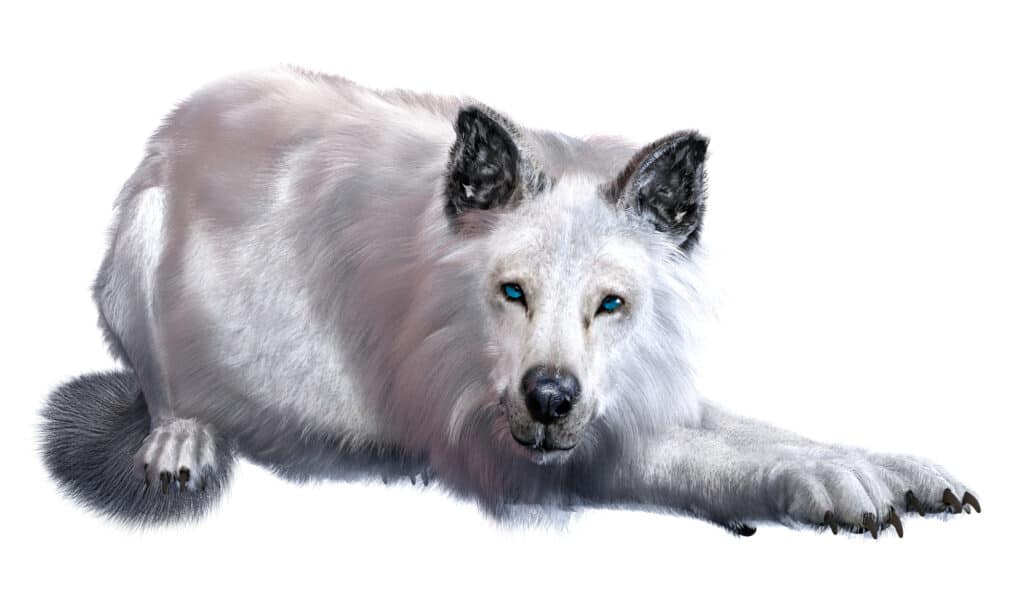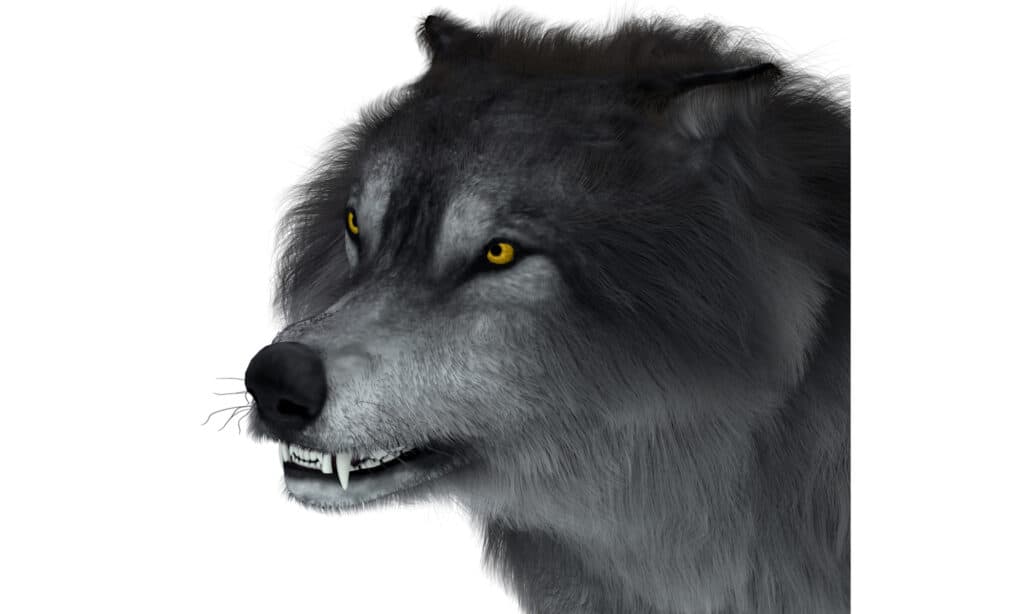The dire wolf is a prehistoric canine that lived in the Americas and some parts of Asia between 125,000–9,500 years ago (Late Pleistocene and Early Holocene epochs). The first fossil of this ancient beast was found in 1858 and was given the name Canis dirus, which translates as “terrible wolf.”
Fans of the popular television series Game of Thrones will probably be familiar with this ancient canine that roamed the earth thousands of years ago. This powerful canine is arguably North America‘s most famous ancient predator.
Description and Size
Dire Wolves were pretty similar in appearance to the present-day gray wolf. However, recent findings reveal that they may not be as closely related as earlier thought. Still, they’re pretty similar to the gray wolf in appearance.
Dire Wolves are slightly bigger than present-day wolves. From the size of their skeletons, they are as much as 20% larger. They are considered the largest of all the ancient canines in North America during the Late Pleistocene era.
Their skulls measured about 13 inches, while their average body length was about 69 inches. Dire wolves had a shoulder height of about 38 inches. There are at least two subspecies in the family. These are the Aenocyon dirus guildayi and Aenocyon dirus dirus. The A. guildayi, the smaller of these two subspecies, might have weighed about 132 pounds. The Larger A. dirus dirus probably weighed around 150 pounds. One fossil discovered in Florida was estimated by scientists to have weighed as much as 200lbs.

Dire wolves were widespread apex predators that competed for food with sabretooth tigers and, eventually, humans.
©Seeker Stock Art/Shutterstock.com
Diet – What Did Dire Wolves Eat?
The skull and dentition of the dire wolf are similar to that of the present-day gray wolf. However, the teeth were much larger, giving the prehistoric canine a stronger bite force and greater shearing ability than gray wolves or other canine species. This adaptation was necessary because they lived alongside megaherbivores like western horses, mastodons, ancient bison, ground sloths, and camels which they preyed on.
Habitat – When and Where It lived
Paleontologists have found fossils of dire wolves in various parts of North America, South America, and Asia. They’re among the most famous ancient canines in North America, suggesting that they lived predominantly in this area. However, the recent discovery and identification of the Jaw of a dire wolf in China indicate that they most likely crossed into Asia from North America using the prehistoric Bering Land Bridge. These big wolves have a wide fossil distribution. In the United States, fossils were found around the Pacific and Atlantic coasts and as far north as Alaska. This widespread distribution suggests excellent adaption. The species must have been well adapted to various habitats, including grasslands, coastal woodlands, and tropical wetlands.

Scientists believe that one dire wolf specimen weighed 200 pounds when it was alive.
©Catmando/Shutterstock.com
Threats and Predators
The Dire wolf was a prominent apex predator when it roamed the earth. It had very few threats, although it did have some other prominent predator species such as the Sabertooth tigers that competed with it for food. Humans also appeared before their extinction, and there is evidence to suggest that both species competed for food.
This competition for food and the resultant scarcity of prey probably posed the biggest threat the dire wolf population encountered. In some of the fossils of the dire wolf identified, scientists could use changes in the dire wolf’s teeth over time to predict its diet. Scientists used this to establish the dire wolf’s relationship with other predator species that lived within the same period. It was evident that competition between the dire wolf and the other animal species was a major issue.
Towards the end of their existence, humans were probably the biggest threat to their population. They were better hunters, meaning they could take down large prey, leaving nothing for the dire wolf.
Discoveries and Fossils – Where It Was Found
The first fossil of these ancient predators ever discovered was found in 1854 in the bed of the Ohio River. But scientists didn’t name it until four years later. Paleontologists have identified two different subspecies of dire wolves. These are Aenocyon dirus guildayi and Aenocyon dirus dirus.
The most extensive collection of fossils ever discovered from Los Angeles’ Rancho La Brea Tar Pits. The remains were found along with the remains of several other prehistoric animals from the same period.
Although they seem very well distributed, dire wolf fossils have rarely been found anywhere North of 42°N latitude. Scientists attribute this to temperature, habitat limitation, and the absence of prey to feed on in these areas. However, the discovery of fossils in China suggests that the beasts did wander that far at some point.

Extinction – When Did Dire Wolves Die Out?
The dire wolf disappeared along with many other animal species as part of the Quaternary extinction event, which occurred between 13,000 BCE to 8,000 BCE. The last of the dire wolves probably disappeared around 9,500 years ago.
One major factor that might have contributed to the decline of their population is increased competition for food, particularly with the newly arrived human population. The scarcity of food and the presence of a better-adapted hunter contributed to the extinction of these canines. They eventually disappeared during the Quaternary extinction event. Aside from the fact that humans were better hunters, many mammals that made up the big wolf’s diet also disappeared around this period.
Similar Animals to the Dire Wolf
- Sabretooth tiger – The Sabertooth tiger is a prehistoric apex predator that existed alongside the dire wolf. Both species most likely competed for the same megaherbivores as food.
- African jackal – DNA analysis shows that the African Jackal is a lot similar to the dire wolf. The species appeared around 5.1 million years ago and is still in existence today.
- Pleistocene wolf – The gray wolf, which is still in existence today, is the direct descendant of the Pleistocene wolf. This wolf species share a similar skeletal structure with the dire wolf, although it is slightly smaller.
Up Next
Dire wolf size comparison – See how dire wolves compare to real-life references in terms of size.
Sabertoothed Tiger – Discover the sabertooth, another massive apex predator that lived in the Quaternary
Weirdest snakes that are real– Since we’re talking about what’s real and isn’t, these are 9 weird snakes that still crawl the planet to this day
The photo featured at the top of this post is © Catmando/Shutterstock.com
FAQs (Frequently Asked Questions)
When did dire wolves live?
Dire wolves roamed the earth between 125,000–9,500 years ago. This was between the Late Pleistocene and Early Holocene epochs. Scientists often link the disappearance of the dire wolves to the last ice age, which covered vast areas of the planet with glaciers.
How big was the dire wolf?
The dire wolf has a similar skeletal composition as present-day gray wolves. However, they’re about 25% larger. Their average height was about 38inches at the shoulder, and their body length was about 69 inches. They weighed between 150 – 200lbs on average.
Why did the dire wolf go extinct?
The dire wolf went extinct about 9500 years ago due to various factors. The disappearance of the big mammals, which was their primary source of food, was the major cause. Scientists also think that they could not adapt to competition with humans who were better hunters than they were.
Were dire wolves real?
Yes. Dire wolves were real. Although they are now extinct, dire wolves walked the earth alongside our ancient ancestors until about 9,500 years ago.
Thank you for reading! Have some feedback for us? Contact the AZ Animals editorial team.






